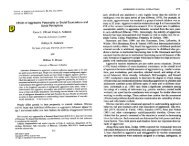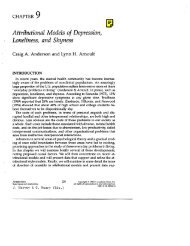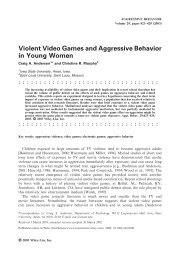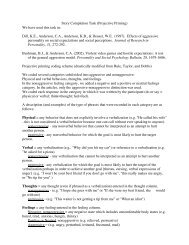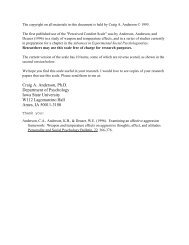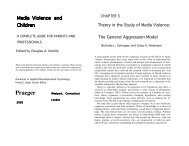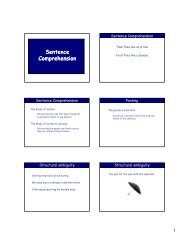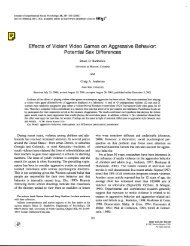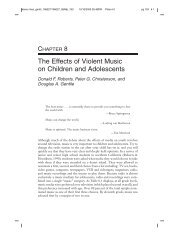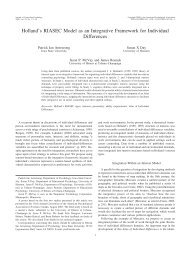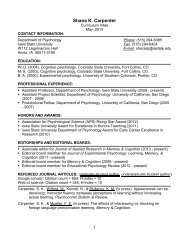The General Aggression Model: Theoretical Extensions to Violence
The General Aggression Model: Theoretical Extensions to Violence
The General Aggression Model: Theoretical Extensions to Violence
You also want an ePaper? Increase the reach of your titles
YUMPU automatically turns print PDFs into web optimized ePapers that Google loves.
254 DEWALL, ANDERSON, AND BUSHMAN<br />
would direct the individual <strong>to</strong> treatments directed<br />
at each specific risk fac<strong>to</strong>r. For example,<br />
individuals who have positive beliefs about suicide<br />
may be exposed <strong>to</strong> therapeutic treatment<br />
aimed at changing the individual’s suicide beliefs.<br />
Individuals who chronically feel rejected<br />
would be given opportunities for renewed affiliation,<br />
which quickly reduces the harmful effects<br />
of social rejection (DeWall, Baumeister, &<br />
Vohs, 2008; DeWall, Twenge, et al., 2010).<br />
Third, therapists would identify whether an<br />
individual possesses emotional responses, cognitive<br />
processes, or arousal levels associated<br />
with a risk for suicide. After identifying those<br />
risk fac<strong>to</strong>rs, the therapist would offer the individual<br />
treatments aimed at alleviating each risk<br />
fac<strong>to</strong>r. Among individuals who have become<br />
desensitized <strong>to</strong> graphic images and physical<br />
pain, for example, treatments would center on<br />
limiting exposure <strong>to</strong> situations that might increase<br />
such desensitization (e.g., exposure <strong>to</strong><br />
weapons, violent media) and providing medical<br />
attention <strong>to</strong> limit any physical damage that may<br />
enhance the individual’s desensitization.<br />
Fourth, therapists would motivate individuals <strong>to</strong><br />
perceive suicide as having an outcome that is<br />
deeply important and unsatisfying for them personally<br />
and their loved ones. By focusing individuals<br />
<strong>to</strong> engage in such appraisal processes,<br />
individuals may be more likely <strong>to</strong> engage in<br />
thoughtful action that does not involve suicide.<br />
Using GAM <strong>to</strong> Explain Nonviolent<br />
Behavior<br />
Whereas the previous sections have emphasized<br />
how GAM can be used <strong>to</strong> explain violence<br />
in four novel ways, this section demonstrates<br />
that GAM also can be used <strong>to</strong> explain nonviolent<br />
behavior. Most theories of violence are<br />
used <strong>to</strong> explain the causes of these behaviors in<br />
contexts in which they occur somewhat frequently.<br />
At first blush, it might seem natural for<br />
GAM <strong>to</strong> be used only <strong>to</strong> explain behavior in<br />
societies marked by relatively frequent instances<br />
of violence. We argue that GAM also<br />
may be used <strong>to</strong> explain the nonoccurrence of<br />
violence in relatively peaceful societies.<br />
<strong>The</strong>re are not very many of them, but there<br />
are some societies in which war is a foreign<br />
word and violence is extremely rare (Bonta,<br />
1997; Fry, 2007). For example, more than 100<br />
years ago, the Fipa of western Tanzania trans-<br />
formed their society from one based on violence<br />
and war <strong>to</strong> one based on nonviolence and peace.<br />
<strong>The</strong> Fipa are very competitive in their business<br />
dealings, but the competition is constructive and<br />
peaceful (Willis, 1989). Another peaceful society<br />
is the Jains of India. <strong>The</strong> Jains believe in<br />
ahimas (nonviolence), and they take vows <strong>to</strong><br />
avoid any socially harmful acts, including stealing<br />
and telling lies.<br />
But even in these largely peaceful societies,<br />
GAM can explain both the predominance of<br />
nonviolence and the rare cases in which people<br />
engage in violent and aggressive behavior. Because<br />
their lives are filled with largely cooperative<br />
and prosocial experiences, people embedded<br />
in highly peaceful societies do not develop<br />
enriched aggressive knowledge structures. As a<br />
result, violence and aggression in peaceful societies<br />
should occur primarily as a result of<br />
situational fac<strong>to</strong>rs that give rise <strong>to</strong> internal states<br />
and appraisal and decision processes associated<br />
with impulsive actions.<br />
GAM can also explain why peaceful societies<br />
remain peaceful—and how societies marked by<br />
frequent war and violence can become more<br />
peaceful. Unpleasant stimuli and interpersonal<br />
conflict are inevitable, which can increase aggressive<br />
affect, cognition, and arousal. But<br />
members of peaceful societies likely appraise<br />
the outcome of an aggressive action as a significant<br />
and unsatisfying break from norms that<br />
encourage cooperation and peaceful conflict<br />
resolution, leading them <strong>to</strong> engage in a thoughtful<br />
nonviolent action. In a similar fashion, societies<br />
marked by frequent violent conflicts can<br />
become less violent when norms that formerly<br />
advocated violence now encourage citizens <strong>to</strong><br />
exercise self-control <strong>to</strong> override their violent<br />
impulses. <strong>The</strong> eminent sociologist Norbert Elias<br />
(1969, 1982) argued that European societal<br />
norms changed from the 9th century <strong>to</strong> the 19th<br />
century <strong>to</strong> encourage people <strong>to</strong> exercise restraint<br />
over their violent impulses and <strong>to</strong> shame people<br />
who failed <strong>to</strong> do so, which Elias referred <strong>to</strong> as a<br />
“civilizing process.” Other work has shown that<br />
modern civilizations are the most peaceful in<br />
the his<strong>to</strong>ry of the world in terms of deaths by<br />
war (Keeley, 1996) and murder (Eisner, 2003),<br />
presumably as a result of changes in the situational<br />
context that encourage people <strong>to</strong> override<br />
their violent impulses. Thus, although unpleasant<br />
stimuli and interpersonal conflict pervade<br />
human life, GAM argues that appraising the



